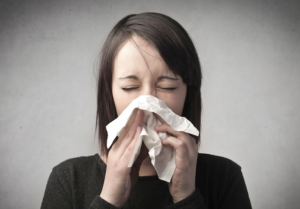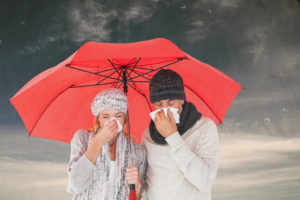 As Winter begins and the temperatures plummet, the cold air can cause havoc on individuals with certain allergic and immunologic conditions that are caused or made worse with cold weather. Some of the allergic and immunologic conditions that are exacerbated by cold weather include cold-induced pruritus (itching), cold-induced urticaria (hives), cold-induced angioedema, (swelling), cold-induced anaphylaxis, Raynaud’s disease, Raynaud’s phenomenon, cryoglobulinemia, cold agglutinin disease, and cold-induced asthma.
As Winter begins and the temperatures plummet, the cold air can cause havoc on individuals with certain allergic and immunologic conditions that are caused or made worse with cold weather. Some of the allergic and immunologic conditions that are exacerbated by cold weather include cold-induced pruritus (itching), cold-induced urticaria (hives), cold-induced angioedema, (swelling), cold-induced anaphylaxis, Raynaud’s disease, Raynaud’s phenomenon, cryoglobulinemia, cold agglutinin disease, and cold-induced asthma.
Cold-induced Pruritus, Urticaria, Angioedema, and Anaphylaxis
Cold-induced pruritus, cold-induced urticaria, cold-induced angioedema, and cold-induced anaphylaxis are all very similar conditions. The major difference between them is the severity of the reaction to the cold. Exposure to cold temperatures can result in itching, hives, swelling, and/or anaphylaxis to the cold-exposed part of the body. Cold-induced pruritus, cold-induced urticaria, and cold-induced angioedema are conditions with increasing severity respectively. Cold-induced urticaria can usually be diagnosed by an allergist in the office by an “ice cube test,” where an ice cube is placed on the forearm of the patient for 10 to 15 minutes and then removed. When the skin re-warms in a few minutes, an elevated red wheal or hive in the shape of the ice cube confirms this disorder. Cold-induced angioedema can be very serious if swelling develops in the tongue and/or throat which can potentially block the flow of air into the lungs. In such circumstances, these patients should be taught how to use a self-injectable epinephrine devices (i.e., EpiPen, Auvi-Q) and they should carry them at all times. If used, they should go to the nearest emergency room, even after using the epinephrine. Cold-induced anaphylaxis is a life-threatening condition where the cold causes a systemic reaction which involves several body systems such as the skin, respiratory, and circulatory systems. Again, these individuals should be taught how to use a self-injectable epinephrine devices and they should carry them at all times. If used, they should go to the nearest emergency room, even after using the epinephrine. Individuals that have severe reactions to the cold need to be educated on how to help prevent these reactions as well as how to treat them. Treatment begins with avoiding the cold whenever possible. In addition, various medications can be used to help prevent the itching, hives, swelling and/or anaphylaxis that may occur in people with these conditions.
Rarely, the above conditions can be associated with some systemic diseases and blood tests for cryoglobulins and cold agglutinins may be appropriate. A brief summary of these 2 rarer diseases are discussed below.
Cryoglobulinemia
Cryoglobulinemia is a disease in which patients have high levels of immunoglobulins (antibodies) that bind together and “clump up” to form a “precipitate” in the bloodstream when the body’s temperature drops below the normal 98.6°F. The majority of the immunoglobulins are Immunoglobulin M (IgM), but Immunoglobulin G (IgG), and Immunoglobulin A (IgA) also cause this disease. These antibodies are thus called cryoglobulins since the prefix “cryo” means “cold” in Greek. When these cryoglobulins form a precipitate, it causes an obstruction in the blood vessels and blocks the flow of blood to the periphery. As a result, it may cause gangrene in the fingers and toes since less or no blood reaches these areas. Damage can also occur in the skin, joints, nerves, muscles, kidney, and liver. Interestingly, when the body temperature reaches 98.6°F again, usually by warming methods used in therapy, the cryoglobulins go back into solution causing the precipitate to “dissolve” and the flow of blood is re-instated through the blood vessels again. The disease is most common in individuals 50 years of age and above and there are 3 types of cryoglobulinemia. The causes of cryoglobulinemia may include several underlying diseases or conditions. Some of the more common underlying disorders include multiple myeloma, Waldenström’s macroglobulinemia, autoimmune disorders such as rheumatoid arthritis and systemic lupus erythematosus (lupus), certain leukemias, and infections such as Mycoplasma pneumonia, hepatitis C, hepatitis B, post-streptococcal glomerulonephritis, and HIV. The treatment of cryoglobulinemia begins with treating the underlying disorder. Keeping the individual warm with protective clothing, avoiding cold liquids, and avoiding exercise in the cold, can all help prevent the body temperature from getting too low.
Cold Agglutinin Disease
In cold agglutinin disease, patients have high levels of Immunoglobulin M (IgM) antibodies in their bloodstream which attack their own red blood cells when their body temperature is below 88°F. Occasionally, the antibody Immunoglobulin G (IgG) or even rarer, the antibody IgA (IgA) can cause this disorder. When the red blood cells are attacked, they are destroyed, leading to a type of anemia (low red blood cell count). As with cryoglobulinemia, there may be an underlying illness or condition causing cold agglutinin disease. Some of these underlying causes may be due to chronic lymphocytic leukemia, lymphoma, Waldenström’s macroglobulinemia, and infections such as mononucleosis, HIV, and Mycoplasma pneumonia. Treating the underlying disorder, as well as keeping the patient warm by using protective clothing, avoidance of drinking cold liquids, eating good sources of folic acid in fruits and vegetables, and avoidance of strenuous exercise, particularly in the cold air all are effective in the management of this disease.
Raynaud’s Disease and Raynaud’s Phenomenon
Raynaud’s disease and/or Raynaud’s phenomenon occurs when there is decreased blood flow to the fingers, toes, nose, and/or earlobes when someone is exposed to the cold. It is thought to occur as a result of vasospasm (spasm of the blood vessel) causing the decrease in blood flow. These vasospastic events are generally episodic in nature. Initially the skin of these regions turns a whitish-pale color. At this point, the skin feels cold and can feel numb. The oxygen supply is thus reduced causing a bluish tint to the skin. When the episode is finished and/or the body part gets re-warmed, blood flow to the skin areas is resumed and the skin turns reddish in color and then finally the color becomes normal. This phase is generally accompanied by local swelling with an associated tingling pin and needle sensation like when someone’s fingers or toes “fall asleep.” It is often referred to the disease that is red, white, and blue. Raynaud’s disease and Raynaud’s phenomenon are more common in females. The term Raynaud’s Disease is used when there is no reason identified as an underlying reason for the vasospasm. On the other hand, Raynaud’s phenomenon is used to describe the same situation only when there is an identifiable underlying condition that is believed to cause the decreased blood flow. Some of the underlying secondary diseases may include autoimmune or connective tissue disorders such as systemic lupus erythematosus (lupus), systemic sclerosis (scleroderma), polymyositis, dermatomyositis, Sjögren’s syndrome, mixed connective tissue disease, rheumatoid arthritis, and Takayasu’s arteritis. Other underlying conditions known to cause Raynaud’s phenomenon include atherosclerosis, malignancy, hypothyroidism, multiple sclerosis, Lyme disease, carpal tunnel syndrome, and certain medications (e.g., beta blockers, sulfasalazine, ergotamine, bromocriptine, bleomycin, pseudoephedrine, methylphenidate, dexmethylphenidate). The treatment of Raynaud’s phenomenon is primarily to treat the underlying condition. In addition, with both Raynaud’s disease and Raynaud’s phenomenon, it is important to keep warm by wearing gloves, mittens, socks, scarves, ear muffs, and hats. There are several medications that can also be given such as alpha blockers, calcium channel blockers, and vasodilators.
Cold-induced Asthma
Cold dry air is a known irritant to the respiratory passages and can trigger an increase in the frequency and severity of asthma. The symptoms that asthmatics experience may include wheezing, chest tightness, coughing, and/or shortness of breath. Exercising in the cold is even worse in many patients with asthma. It is important for individuals with asthma to understand their triggers and to pre-medicate, with some of their asthma medications, before venturing out into the cold. The patient should also understand when to call their allergist, before their asthma symptoms get out of control.
The board certified allergists at Black & Kletz Allergy have been treating cold-induced allergic and immunologic conditions in adults and children. We have been providing quality allergy care to those located in the Washington, DC, Northern Virginia, and Maryland metropolitan area for more than 50 years. Black & Kletz Allergy provides on-site parking at all of their convenient locations in Washington, DC, McLean, VA (Tysons Corner, VA), and Manassas, VA. The Washington, DC and McLean, VA locations are Metro accessible and there is a complementary shuttle that runs between our McLean office and the Spring Hill metro station on the silver line. Please call any one of our offices for a consultation for your allergy, asthma, or sinus needs or alternatively, please click Request an Appointment and we will respond within 24 hours on the next business day.
 Serving as Vienna, Centreville, and Arlington allergists, we have noticed that we are experiencing a relatively mild Winter so far. Some reports indicate that this is the third balmiest winter in several decades. The grass is still green in many of our yards and the air is warmer and moister than usual.
Serving as Vienna, Centreville, and Arlington allergists, we have noticed that we are experiencing a relatively mild Winter so far. Some reports indicate that this is the third balmiest winter in several decades. The grass is still green in many of our yards and the air is warmer and moister than usual.
 As Winter begins and the temperatures plummet, the cold air can cause havoc on individuals with certain allergic and immunologic conditions that are caused or made worse with cold weather. Some of the allergic and immunologic conditions that are exacerbated by cold weather include cold-induced
As Winter begins and the temperatures plummet, the cold air can cause havoc on individuals with certain allergic and immunologic conditions that are caused or made worse with cold weather. Some of the allergic and immunologic conditions that are exacerbated by cold weather include cold-induced